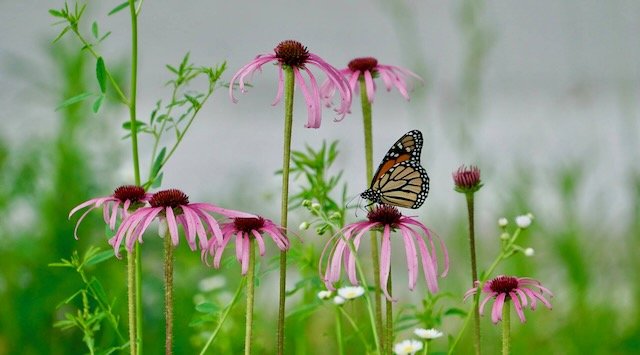This is a special time of year for me and I hope for everyone else, too. As I drive through town or on the highway, the many colors catch my eye. I especially love the dogwood trees in full bloom and then you have that bright splash of magenta of the redbuds, which seem to scream “Look at Me!”. These are only two trees that are blooming right now that always bring a smile to my face. I always welcome the freshness of color in the spring after a long drab winter.
Dogwood trees are special to Missouri since it is the State tree. It is also special during Easter for many Christians because of the story of what it represents.
In Jesus’ time, the dogwood grew
to a stately size and a lovely hue.
‘Twas strong and firm, its branches interwoven.
For the cross of Christ its timbers were chosen.
Seeing the distress at this use of their wood
Christ made a promise which still holds good
"Never again shall the dogwood grow
Large enough to be used so.
Slender and twisted, it shall be
With blossoms like the cross for all to see.
As Blood stains the petals marked in brown,
The blossom’s center wears a thorny crown.
All who see it will remember ME
Crucified on a cross from the dogwood tree.
Cherished and protected, this tree shall be
A reminder to all of My agony.”
--- Anonymous
There is no proof that the dogwood tree was used in the making of the cross. I can’t imagine seeing this beautiful short, but shapely tree being able to be used this way, but there is proof that the wood of the dogwood has been a useful wood. For example wheels, golf clubs, hay forks and weaving shuttles, and to this day walking canes and many golf heads, tool handles and spindles are still being made with dogwoods.
There are many interesting but often unknown facts about dogwood trees. They not only are beautiful they provide food and shelter to a wide variety of wildlife. They were very useful in providing dyes for the Native Americans and are still used today. A dogwood has medicinal properties with almost all of its parts, and it also rejuvenates our soil. Dogwoods are Hermaphrodites, meaning they contain both male and female reproductive parts. When insects pollinate the flowers, they produce small red berries. There are many varieties of dogwood species, not all native, but there are several native dogwood shrubs that are being used for landscape and soil erosion which include the red twig, silky and rough - leaved and many more.
As for the Eastern redbuds that scream, “Look at Me!” they, too, are a sign to celebrate the end of the winter. If you ever stop and take a close look at these trees during the blooming season, those bright little pea-shaped flowers stick out from the bare bark and cover the branches of the tree. These flowers are pollinated by long-tongued bees such as blueberry bees and carpenter bees. They, too, are coming to the end of their blooming season and soon your eye will be picking up the bronze color of a glossy heart shaped leaf. These leaves will develop into a deep green, shaping a dense, compact tree.
They are a hardy tree, but their trunks have a tendency to divide close to the ground, creating multi- trunk looking trees. In the fall, the leaves turn a bright yellow, then drop, leaving the brown seed pod cluster which cling deep into the winter.
I was never a fan of redbud trees before becoming a Master Naturalist, because of the mess they produced with their seed pods at the end of the season and the many volunteer trees they produced. I always shied away from them, but I have a different outlook on them now. They are a beautiful tree, stay very compact in a landscape setting, and are particularly stunning in a grouping. Being a native tree to Missouri, this tree is tolerant to the harsh weather in both summer and winter. Even though this tree has a dense, heavy, wood, it is not strong. However, be prepared for a fight if you ever try to saw it because it has a coarse grain. The wood is a pretty reddish-brown color. It is always smart to water occasionally throughout the year.
As I look at the vast open space on the property I have due to the 2011 Joplin EF5 tornado, I will begin planning the layout of the property. It will include both of these trees along with a variety of native trees and shrubs. I have been a Missouri Master Naturalist since 2007 in the Chert Glades chapter and continue to learn from this program.
Article & photos by Karen Garver


